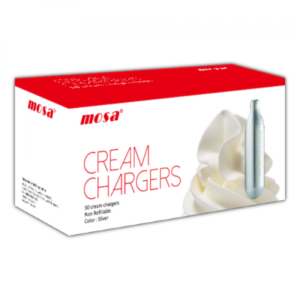Introduction
In today's world, sustainability is no longer simply a buzzword; it's a necessity. As markets grapple with their ecological impact, the manufacturing sector is stepping up to fulfill these obstacles head-on. One area where considerable strides are being made is in the production of N2O cream charger tanks These small yet important gadgets, typically known as cream chargers, are critical in numerous cooking applications, especially for whipping cream and developing frothy textures. But cream chargers how can we guarantee these products are made sustainably? This post looks into the sustainable developments in the production of N2O cream battery charger tanks, checking out both the technological improvements and practices that are making a difference.
Understanding N2O Cream Battery charger Tanks
What Are N2O Cream Charger Tanks?
N2O cream battery charger tanks are little metal cartridges filled with nitrous oxide (N2O), which is utilized to create whipped cream by pressurizing cream. These cylinders, often described as whipped cream battery charger tanks or just nangs, have become increasingly popular in both commercial cooking areas and home cooking.

The Role of Nitrous Oxide
Nitrous oxide, typically called laughing gas, has actually been used for its homes in different fields, consisting of medicine and culinary arts. In the context of whipped creams and other foams, it functions as a propellant that produces air bubbles when released from the tank.
Types of Cream Charger Tanks
There are several types of cream charger tanks readily available on the market:
- Whipping Cream Battery charger Tanks Nitrous Oxide Cream Charger Tanks Cream Battery charger Canisters Cream Charger Cylinders
Each type serves a specific purpose but shares typical manufacturing processes that can be optimized for sustainability.
Sustainable Innovations in the Production of N2O Cream Charger Tanks
Eco-Friendly Materials
One substantial development in sustainable practices involves using environmentally friendly products in production. Companies are now checking out biodegradable and recyclable products for producing these battery chargers. Switching from traditional metal to more sustainable options can considerably decrease waste and energy consumption during production.
Benefits of Eco-Friendly Materials
Reduction in Carbon Footprint: Using renewable resources minimizes reliance on fossil fuels. Enhanced Recycling Potential: More products ending up being recyclable methods less pressure on landfills. Consumer Appeal: Eco-conscious customers prefer brands that show sustainability efforts.Energy-Efficient Production Techniques
Manufacturers are increasingly adopting energy-efficient procedures to produce their N2O cream charger tanks. Ingenious innovations such as solar energy, regenerative heat systems, and optimized equipment aid lower energy use throughout production cycles.
How Energy Effectiveness Advantages Manufacturers
- Lower operational costs due to lowered energy consumption Enhanced brand name reputation among ecologically conscious consumers Compliance with future guidelines concerning emissions and energy use
Waste Reduction Strategies
Implementing waste reduction strategies throughout production can significantly contribute to sustainability objectives. By optimizing procedures, manufacturers can lessen scrap materials and improve total efficiency.
Examples of Waste Reduction Practices
Lean Production Techniques: Enhancing operations lowers product waste. Closed-loop Systems: Reusing scrap material within production helps minimize waste. Digital Tracking Systems: Tracking resource usage allows for much better management decisions.The Environmental Impact of Nitrous Oxide Production
Understanding Nitrous Oxide's Effects on Climate Change
Although nitrous oxide plays an essential role in cooking applications, its production has noteworthy ecological impacts. As a powerful greenhouse gas, N2O contributes considerably to climate change if not handled properly.

Mitigation Methods for Nitrous Oxide Emissions
Improved Production Methods: Adopting approaches with lower emissions during nitrous oxide production. Carbon Capture Technologies: Investing in technologies that record carbon emissions from nitrous oxide facilities. Regulatory Compliance: Following stricter standards concerning emissions releases.Recycling Initiatives for N2O Cream Battery Charger Tanks
Importance of Recycling Cream Chargers
Recycling utilized N2O cream charger tanks offers various advantages, consisting of minimizing environmental impact and saving resources required for brand-new product creation.
Steps Towards Effective Recycling Programs
Consumer Education Campaigns: Informing consumers about proper disposal methods. Partnerships with Recycling Facilities: Collaborating with regional recycling centers makes sure efficient processing. Return Programs: Carrying out programs where consumers can return empty battery chargers for recycling incentives.FAQs About Sustainable Developments in the Manufacturing of N2O Cream Charger Tanks
1. What products are used in making N2O cream charger tanks?
Most N2O cream charger tanks are made from steel or aluminum however more recent innovations focus on utilizing biodegradable alternatives.
2. How does nitrous oxide contribute to climate change?
Nitrous oxide is a greenhouse gas that can trap heat in the environment over 300 times better than co2 when not handled properly.
3. Exist any eco-friendly brands producing cream chargers?
Yes! Lots of brand names now focus on sustainability by making use of environmentally friendly materials and executing green manufacturing processes.
4. What recycling alternatives do I have actually for utilized cream chargers?
Many areas provide recycling programs specifically designed for metal products like cream chargers; check local guidelines or return programs used by manufacturers.
5. How can I ensure I'm purchasing sustainable products?
Look for certifications or identifying indicating eco-friendly practices or inspect makers' info about their sustainability efforts.
6. Is there an option to nitrous oxide for whipping creams?
While nitrous oxide stays popular due to its effectiveness, some alternatives like compressed air systems exist but might not attain the same outcomes efficiently.
Conclusion
As consumer awareness grows about ecological problems, manufacturers need to adapt their practices accordingly-- especially those involved in producing vital items like N2O cream charger tanks which play substantial roles across various sectors today! Through sustainable innovations encompassing environment-friendly products, energy-efficient production techniques, extensive recycling initiatives-- all complemented by regulative compliance-- companies will not only boost their track records however likewise contribute favorably towards reducing climate modification effects associated with conventional manufacturing methods!
This article has actually checked out numerous measurements surrounding sustainable developments within this specific niche market-- showcasing how embracing duty through development paves pathways towards greener futures while still providing quality products like whipped creams delighted in globally!
For further insights into this subject or related inquiries concerning other aspects surrounding food technology & & precaution within culinary arts-- do not hesitate reaching out!